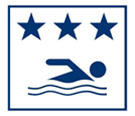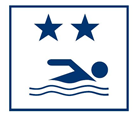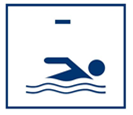Seawater monitoring in Jersey
We monitor seawater quality to:
- measure compliance against the EU Bathing water directive
- get valuable information for Islanders and tourists on the quality of seawater
- identify episodes of pollution
- provide information to other stakeholders including the Aquaculture Industry
The people involved in seawater monitoring and their contact details:
- officers from the Water and Air team, phone: +44 (0) 1534 441600
- officers from the Pollution Control team, phone: +44 (0) 1534 709535
- Environmental Health who in consultation can advise on the safety of swimming if we have poor results. Phone: +44 (0) 1534 445808
- the Official Analyst’ laboratory staff who carry out the analysis. Phone: +44 (0) 1534 736455
The monitoring of seawater provides valuable public health data, however it is only a snap-shot of the water quality at the time of sampling and bathers and other recreational users enter coastal waters at their own risk. General public health advice is to avoid swimming for 48 hours following heavy rainfall and to avoid seafoam if present.
If you notice pollution on the beach or in the sea, call +44 (0) 1534 709535.
iframe place holder
iframe URL:
https://govje.maps.arcgis.com/apps/Embed/index.html?webmap=2e689229ffb245528ed70f7933026105&level=12&home=true&zoom=true&previewImage=true&scale=false&search=false&searchextent=true&basemap_gallery=false&disable_scroll=true&theme=light%22%3e%3c/div
width:800
height:550
Open seawater results map
Open seawater results table
Non-routine sampling
We may sometimes undertake additional sampling if there are concerns about the quality of the bathing water.
Bathing water classifications
 | Excellent water quality Indicates this sample meets the following standard:
- less than or equal to 250 Escherichia coli per 100ml
- less than or equal to 100 Intestinal enterococci per 100ml
|
 | Good water quality Indicates this sample meets the following standard: - less than or equal to 500 Escherichia coli per 100ml
- less than or equal to 200 Intestinal enterococci per 100ml
|
 | Poor water quality Indicates values are above 500 Escherichia coli per 100ml and above 200 Intestinal enterococci per 100ml |
Monitoring schedule
We monitor seawater from Tuesday 13 May to Tuesday 24 September as part of the EU Bathing Water Directive. You can find the most recent results on the map and table above.
May
| 13 and 14 May 2025
|
|---|
May
| 19 and 20 May 2025
|
|---|
May
| 27 and 28 May 2025
|
|---|
June
| 2 and 3 June 2025
|
|---|
June
| 9 and 10 June 2025
|
|---|
June
| 16 and 15 June 2025
|
|---|
June
| 21 and 22 June 2025
|
|---|
June
| 28 and 29 June 2025
|
|---|
July
| 7 and 8 July 2025
|
|---|
July
| 14 and 15 July 2025
|
|---|
July
| 21 and 22 July 2025
|
|---|
July
| 28 and 29 July 2025
|
|---|
August
| 4 and 5 August 2025
|
|---|
August
| 11 and 12 August 2025
|
|---|
August
| 18 and 19 August 2025
|
|---|
August
| 26 and 27 August 2025
|
|---|
September
| 1 and 2 September 2025
|
|---|
September
| 8 and 9 September 2025
|
|---|
September
| 15 and 16 September 2025
|
|---|
September
| 23 and 24 September 2025
|
|---|
List of bays we monitor
We monitor 16 bays around Jersey:
- St Brelade Bay
- Beauport
- Portelet
- Le Braye
- Plémont
- Greve de Lecq
- Watersplash, St Ouen's Bay
- Bonne Nuit
- La Haule
- Victoria Pool, St Aubin's Bay
- Grouville
- Archirondel
- Havre des Pas
- Green Island
- Bouley Bay
- Rozel
To ensure accuracy and consistency, a duplicate sample and analysis is done each week by the Official Analysts laboratory.
Water safety for swimming
We provide the seawater data to Environmental Health every week. They analyse the data and consult other stakeholders to make a decision on whether to advise against swimming in specific bays.
If the results are poor, they would notify the media and signage would be displayed at the relevant bays.
Jersey has some of the cleanest water in Europe. Poor seawater quality can happen after periods of heavy rain. You should wait at least 48 hours before you swim after bad weather. This is irrespective of the formal samples taken and analysed by Government.
Sea Foam
We want to highlight that the public health advice is to avoid contact or ingestion of sea foam. Sea foam forms naturally when waves agitate organic matter in seawater, but it can also contain substances that are harmful to health.
These substances can irritate the skin, upset the stomach, or affect breathing, especially in children and pets.
To contact Environmental Health call +44 (0)1534 445808 or email environmentalhealth@gov.je.
New signs fitted at the seawater sampling sites
New signs have been designed and fitted at each monitoring site which provide a QR code which links to the website. They are temporary so will be available only for the bathing waters season (May to September).
Seawater profiles for each bay
A profile has been produced for Jersey's monitored seawaters.
Each profile includes:
- a photograph, description, map of the seawater and surrounding area
- an identification of potential sources of pollution and measures to reduce pollution
- the phone number to report water pollution and contact details for more information
 Archirondel seawater profile
Archirondel seawater profile
 Beauport seawater profile
Beauport seawater profile
 Bonne Nuit seawater profile
Bonne Nuit seawater profile
 Bouley Bay seawater profile
Bouley Bay seawater profile
 Green Island seawater profile
Green Island seawater profile
 Greve de Lecq seawater profile
Greve de Lecq seawater profile
 Grouville seawater profile
Grouville seawater profile
 Havre des Pas seawater profile
Havre des Pas seawater profile
 La Haule seawater profile
La Haule seawater profile
 Le Braye seawater profile
Le Braye seawater profile
 Plémont seawater profile
Plémont seawater profile
 Portelet seawater profile
Portelet seawater profile
 Rozel seawater profile
Rozel seawater profile
 St Brelade's Bay seawater profile
St Brelade's Bay seawater profile
 Victoria Pool seawater profile
Victoria Pool seawater profile
 Watersplash seawater profile
Watersplash seawater profile
When sea water quality monitoring started
Monitoring started in 1992. We now classify our beaches following guidance from the European Directive and by the World Health Organisation.
From 2015 bathing water classifications throughout Europe are based on sampling data collected over 4 years.
Historic data is available from Natural Environment. Call +44 (0) 1534 441600 or email environment@gov.je.